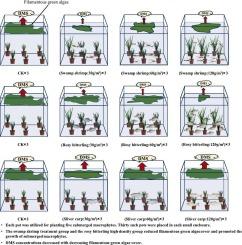当前位置:
X-MOL 学术
›
Sci. Total Environ.
›
论文详情
Our official English website, www.x-mol.net, welcomes your
feedback! (Note: you will need to create a separate account there.)
Regulation of freshwater filamentous green algae (Cladophora) and its impact on malodorous volatile organic sulfur compound (DMS) by biomanipulation
Science of the Total Environment ( IF 8.2 ) Pub Date : 2024-10-15 , DOI: 10.1016/j.scitotenv.2024.176856 Yutai Dai, Yu Lin, Ping Deng, Jiping Chen, Weijie Li, Qiang Gao, Hong Shen, Qiutong Peng, Mo Chen, Xuwei Deng
Science of the Total Environment ( IF 8.2 ) Pub Date : 2024-10-15 , DOI: 10.1016/j.scitotenv.2024.176856 Yutai Dai, Yu Lin, Ping Deng, Jiping Chen, Weijie Li, Qiang Gao, Hong Shen, Qiutong Peng, Mo Chen, Xuwei Deng

|
When improving the water quality of natural bodies such as lakes, the explosive growth of filamentous green alga Cladophora can limit the growth of submerged macrophytes and prevent the water from shifting to a clear state. During the decay of Cladophora , it can cause various water quality issues such as reduced dissolved oxygen, increased nutrient levels and water odor. Biomanipulation, involving the introduction of a suitable density of aquatic animals into the water, can reduce the biomass of filamentous algae. We hypothesized that stocking appropriate densities of aquatic animals could reduce filamentous algal biomass and at the same time reduce the concentration of odorants in the water. Our study investigated the impact of stocking swamp shrimp (Macrobrachium nipponense ), rosy bitterling (Rhodeus ocellatus ), and silver carp (Hypophthalmichthys molitrix ) at low (30 g/m3 ), medium (60 g/m3 ) and high (120 g/m3 ) densities on water quality, biomass of primary producers (such as Cladophora , submerged macrophyte and algae) and malodorous volatile organic sulfur compound dimethyl sulfide (DMS) in the water, respectively. It was found that the swamp shrimp treatment groups and the rosy bitterling high-density groups effectively inhibited the growth of filamentous green algae cover, in which the rosy bitterling high-density group reduced the filamentous green algae mat coverage by 29.65 % compared with the control group. Additionally, the high-density swamp shrimp and rosy bitterling groups notably promoted the growth of submerged macrophytes (Vallisneria denseserrulata ), and significantly reduced the concentration of the malodorous DMS in the water. Overall, stocking swamp shrimp and rosy bitterling can benefit the restoration of aquatic ecology and the maintenance of clear water. However, it is essential to consider potential changes in water quality resulting from excessive stocking density. Therefore, the appropriate density and proportion of stocking should be determined in conjunction with the specific scale of the aquatic ecological restoration project.
中文翻译:

生物操作对淡水丝状绿藻 (Cladophora) 的调控及其对恶臭挥发性有机硫化合物 (DMS) 的影响
在改善湖泊等自然体的水质时,丝状绿藻 Cladophora 的爆炸性生长可以限制沉没的大型植物的生长,并防止水变为清澈状态。在 Cladophora 的衰变过程中,它会导致各种水质问题,例如溶解氧减少、营养水平增加和水味。生物操作,涉及将适当密度的水生动物引入水中,可以减少丝状藻类的生物量。我们假设放养适当密度的水生动物可以减少丝状藻类生物量,同时降低水中加臭剂的浓度。本研究调查了低密度 (30 g/m3)、中密度 (60 g/m3) 和高密度 (120 g/m3) 的沼泽虾 (Macrobrachium nipponense)、玫瑰苦虾 (Rhodeus ocellatus) 和鲢鱼 (Hypophthalmichthys molitrix) 对水质、初级生产者(如枝叶藻、沉水大型植物和藻类)生物量和水中恶臭挥发性有机硫化合物二甲基硫醚 (DMS) 的影响, 分别。结果表明,沼泽虾处理组和玫瑰苦藻高密度组有效抑制了丝状绿藻覆盖物的生长,其中玫瑰苦味高密度组与对照组相比,丝状绿藻垫覆盖率降低了 29.65 %。此外,高密度沼泽虾群和玫瑰苦虾群显著促进了沉水大型植物 (Vallisneria denseserrulata) 的生长,并显著降低了水中恶臭 DMS 的浓度。 总的来说,放养沼泽虾和玫瑰色苦虾有利于恢复水生生态和保持清澈的海水。然而,必须考虑由于放养密度过高而导致的水质潜在变化。因此,应结合水生生态修复工程的具体规模,确定适当的放养密度和比例。
更新日期:2024-10-15
中文翻译:

生物操作对淡水丝状绿藻 (Cladophora) 的调控及其对恶臭挥发性有机硫化合物 (DMS) 的影响
在改善湖泊等自然体的水质时,丝状绿藻 Cladophora 的爆炸性生长可以限制沉没的大型植物的生长,并防止水变为清澈状态。在 Cladophora 的衰变过程中,它会导致各种水质问题,例如溶解氧减少、营养水平增加和水味。生物操作,涉及将适当密度的水生动物引入水中,可以减少丝状藻类的生物量。我们假设放养适当密度的水生动物可以减少丝状藻类生物量,同时降低水中加臭剂的浓度。本研究调查了低密度 (30 g/m3)、中密度 (60 g/m3) 和高密度 (120 g/m3) 的沼泽虾 (Macrobrachium nipponense)、玫瑰苦虾 (Rhodeus ocellatus) 和鲢鱼 (Hypophthalmichthys molitrix) 对水质、初级生产者(如枝叶藻、沉水大型植物和藻类)生物量和水中恶臭挥发性有机硫化合物二甲基硫醚 (DMS) 的影响, 分别。结果表明,沼泽虾处理组和玫瑰苦藻高密度组有效抑制了丝状绿藻覆盖物的生长,其中玫瑰苦味高密度组与对照组相比,丝状绿藻垫覆盖率降低了 29.65 %。此外,高密度沼泽虾群和玫瑰苦虾群显著促进了沉水大型植物 (Vallisneria denseserrulata) 的生长,并显著降低了水中恶臭 DMS 的浓度。 总的来说,放养沼泽虾和玫瑰色苦虾有利于恢复水生生态和保持清澈的海水。然而,必须考虑由于放养密度过高而导致的水质潜在变化。因此,应结合水生生态修复工程的具体规模,确定适当的放养密度和比例。





















































 京公网安备 11010802027423号
京公网安备 11010802027423号